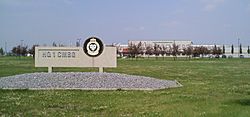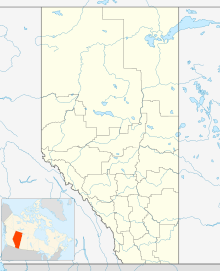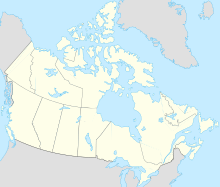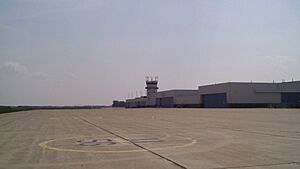CFB Edmonton facts for kids
Quick facts for kids
3rd Canadian Division Support Base Edmonton
CFB Edmonton / BFC Edmonton / Base de soutien de la 3e Division du Canada Edmonton (French)
|
|||||||||||
|---|---|---|---|---|---|---|---|---|---|---|---|

1 Canadian Mechanized Brigade Group at CFB Edmonton
|
|||||||||||
| Summary | |||||||||||
| Airport type | Military | ||||||||||
| Owner | Government of Canada | ||||||||||
| Operator | Department of National Defence (Canada) and Canadian Armed Forces | ||||||||||
| Location | Sturgeon County, near Edmonton, Alberta | ||||||||||
| Built | 1955 | ||||||||||
| Commander | Colonel J.G.P. Lemyre | ||||||||||
| Occupants | 3rd Canadian Division | ||||||||||
| Time zone | MST (UTC−07:00) | ||||||||||
| • Summer (DST) | MDT (UTC−06:00) | ||||||||||
| Elevation AMSL | 2,257 ft / 688 m | ||||||||||
| Coordinates | 53°40′09″N 113°28′32″W / 53.66917°N 113.47556°W | ||||||||||
| Map | |||||||||||
| [[Helipad|]] | |||||||||||
|
|||||||||||
|
Source: Canada Flight Supplement
Environment Canada |
|||||||||||
3rd Canadian Division Support Base Edmonton, often called CFB Edmonton, is a military base in Alberta, Canada. It's located in Sturgeon County, right next to the city of Edmonton. People also know it as Edmonton Garrison or "Steele Barracks".
Contents
History of CFB Edmonton
The story of CFB Edmonton began at an airfield called Blatchford Field. This old airfield was a few kilometers south of where the current base is now. It started in 1927, used by pilots who flew planes into remote areas. The mayor of Edmonton, Kenny Blatchford, supported it.
This airfield became very important for exploring and developing Canada's northern regions. It helped Edmonton become known as the "Gateway to the North."
World War II and Training
During World War II, Blatchford Field became a training base for the Royal Canadian Air Force (RCAF). This was part of a big training program for pilots and aircrew from different countries. Two schools, No. 16 Elementary Flying Training School and No. 2 Air Observers School, used the airfield. Another school, No. 4 Initial Training School, was located at the University of Alberta.
After these training schools closed, the base became known as RCAF Station Edmonton. Many RCAF units were there, including a survival school. Even United States Army Air Forces B-29 bombers used the station.
Supporting the War Effort
The airfield played a big role in helping the Allies of World War II. It was a key stop for U.S. planes defending Alaska. It was also a major point on the Northwest Staging Route, which sent equipment and aircraft to the Soviet military.
Because of all this air traffic, flying became difficult at the old airfield. It couldn't be made bigger because it was too close to Edmonton. So, the U.S. Government built a new air facility at Namao, about 11 kilometers north of the city.
The new base at Namao had two long runways. They were 2,100 meters long and were Canada's longest at the time. The Americans ran the Namao airfield until the war ended. Then, the Canadian Government took it over.
Moving to Namao
The old RCAF Station Edmonton at Blatchford also had problems. So, on October 1, 1955, all RCAF units moved to the "new" RCAF Station Namao. Blatchford Field was then given to the city of Edmonton and became a commercial airport.
During the Cold War, RCAF Station Namao was used by the United States Strategic Air Command. They built a special hangar to fix large jet bombers. The base also hosted the Edmonton Rescue Coordination Centre. It was a home base for United Nations flights that delivered food aid to countries like Ethiopia and Somalia.
Namao had a very long runway, 4,200 meters. Because of this, NASA even named it an emergency landing site for the Space Shuttle.
Becoming CFB Edmonton
In 1968, Canada's armed forces joined together. RCAF Station Namao was renamed Canadian Forces Base Edmonton (Lancaster Park). It was then part of the new Canadian Forces Air Transport Command.
Later, due to government budget cuts, the command of the air station changed. In 1994, it became part of the Canadian Forces Land Force Command and was simply called CFB Edmonton.
Today, the old runways are no longer used for planes. However, a small part of one runway is still used by helicopters. In 2010–2011, the Government of Canada announced new buildings for Canadian Armed Forces members training at CFB Edmonton.
Units at CFB Edmonton
Many important military groups are based at CFB Edmonton. These include:
- 3rd Canadian Division
- 1 Canadian Mechanized Brigade Group
- 1 Canadian Mechanized Brigade Group Headquarters and Signal Squadron
- Lord Strathcona's Horse (Royal Canadians)
- 1 Combat Engineer Regiment
- 1st Battalion, Princess Patricia's Canadian Light Infantry
- 3rd Battalion, Princess Patricia's Canadian Light Infantry
- 1 Service Battalion
- 3rd Canadian Division Support Group
- D Company, 3rd Canadian Division Training Centre
- 6 Intelligence Company
- 1 Canadian Mechanized Brigade Group
- 1 Military Police Regiment
- 1 Field Ambulance
- 1 Dental Unit Detachment Edmonton
- 408 Tactical Helicopter Squadron
CFB Edmonton Today
The main job of CFB Edmonton today is to have a strong, ready-to-fight army group. This group can be sent out to different areas when needed.
CFB Edmonton is the main office for the 3rd Canadian Division. This is the highest army authority in western Canada. It's also home to 1 Canadian Mechanized Brigade Group (1 CMBG), which is the only regular army brigade in the region. The base is located at Steele Barracks, just north of the city.
The base is a very important part of the community around Edmonton. It is home to some of the most experienced units in the Canadian Military.
Deployments and Operations
Units from CFB Edmonton have been involved in many important missions. For example, the 3rd Battalion, Princess Patricia's Canadian Light Infantry, and parts of other units were sent to Afghanistan in 2001 and 2002. This was part of Canada's military response after the September 11 attacks.
Units from the base have also helped in Canada. They assisted during the 1997 Red River flood in 1997. More recently, they helped fight forest fires in British Columbia in 2003. CFB Edmonton units have also taken part in many peacekeeping missions, including in Bosnia and Kosovo.
At the end of March 2010, there were over 4,200 regular military members at CFB Edmonton. There were also over 900 reserve forces and 665 civilian workers. CFB Edmonton has about one-third of the Canadian army's fighting power.
In February 2012, there were talks about using the base's runway for medical flights. This was because the Edmonton City Centre (Blatchford Field) Airport was planning to close. However, it was later decided that all medical flights would use a special facility at the Edmonton International Airport.
On June 7, 2013, the base made history by raising a rainbow flag for Edmonton Pride. This was the first time this flag was flown on a Canadian military base.
CFB Edmonton also took part in Operation Unifier in Ukraine from 2015 to 2016. In August 2016, troops from CFB Edmonton joined the NATO mission in Poland, called Operation Reassurance.




